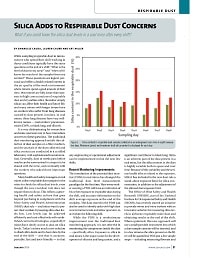Mining Publication: Silica Adds to Respirable Dust Concerns: What If You Could Know the Silica Dust Levels in a Coal Mine After Every Shift?
Original creation date: February 2016
Authors: E Cauda, LG Chubb, AL Miller
While sampling respirable dust in mines, miners who spend their shift working in dusty conditions typically have the same questions at the end of a shift: “What is the level of dust in my area?” and “When will I know the results of the samples from my section?” These questions are logical, personal, and reflect a health-related interest in the air quality of the work environment where miners spend a good amount of their time. Most miners are fully aware that exposure to high concentrations of respirable dust and crystalline silica (hereafter simply silica) can affect their health and future life, and many miners with longer tenure have co-workers who suffer from lung diseases caused by dust present in mines. In coal mines, these lung diseases have very well-known names — coal workers’ pneumoconiosis (CWP), or black lung, and silicosis. The introduction of the personal dust monitor (PDM) in coal mines has changed the traditional dust level measurement paradigm for the first time. Now every worker wearing a PDM will have an indication of his or her exposure to respirable dust during the shift, and accurate information on the shift average exposure at the end of the workday. The data stored in the PDM can also be used to identify tasks with high dust concentration levels and allow operators to act before the following shift. While the PDM is a revolutionary improvement over the traditional dust monitoring approach, it is not selective in monitoring the components inside the dust - specifically silica. Exposure to silica in coal mines is the major cause for the development of silicosis and lung cancer, and a significant contributor to black lung. Silica is an inherent part of the dust present in a coal mine, but the silica content in the dust is highly variable both in space and over time. Because of this variability and the serious health effects related to the exposure, the Mine Safety and Health Administration (MSHA) has included in the new dust rule a stand-alone exposure limit for silica concentration, in addition to the adjustment of the allowed dust exposure limit.

- Analysis of the Silica Percent in Airborne Respirable Mine Dust Samples from U.S. Operations
- Control of Respirable Dust
- Deposition Uniformity of Coal Dust on Filters and its Effect on the Accuracy of FTIR Analyses for Silica
- Evaluation of Diffuse Reflection Infrared Spectrometry for End-of-Shift Measurement of a-quartz in Coal Dust Samples
- Filter Media and Holder Compatible with Personal Dust Monitor and End-of-Shift Crystalline Silica Quantification by Raman and FTIR Spectroscopy
- Investigation into Dust Exposures and Mining Practices in Mines in the Southern Appalachian Region
- Mine Aerosol Measurement
- A Review of Occupational Silica Exposures on Continuous Mining Operations
- Silica...It's Not Just Dust
- Using Real-Time Respirable Dust Monitors to Address the Silica Health Hazard in Mining